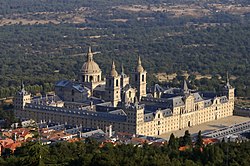Escorial
| Royal Site of San Lorenzo de El Escorial | |
|---|---|

A distant view of the Royal Seat of San Lorenzo de El Escorial
|
|
| Location | San Lorenzo de El Escorial, Spain |
| Coordinates | 40°35′20″N 4°08′52″W / 40.58889°N 4.14778°WCoordinates: 40°35′20″N 4°08′52″W / 40.58889°N 4.14778°W |
| Architect | Juan Bautista de Toledo |
| Governing body | Ministry of the Presidency |
| Official name: Monastery and Site of the Escorial, Madrid | |
| Type | Cultural |
| Criteria | i, ii, iv |
| Designated | 1984 (8th session) |
| Reference no. | 318 |
| State Party |
|
| Region | Europe and North America |
| Official name: Monasterio de San Lorenzo | |
| Type | Real property |
| Criteria | Monument |
| Designated | 3 June 1931 |
| Reference no. | (R.I.) - 51 - 0001064 - 00000 |
The Royal Site of San Lorenzo de El Escorial (Spanish: Monasterio y Sitio de El Escorial en Madrid), commonly known as El Escorial (Spanish pronunciation: [el eskoˈɾi̯al]), is a historical residence of the King of Spain, in the town of San Lorenzo de El Escorial, about 45 kilometres (28 miles) northwest of the capital, Madrid, in Spain. It is one of the Spanish royal sites and functions as a monastery, basilica, royal palace, pantheon, library, museum, university and hospital. It is situated 2.06 km (1.28 mi) up the valley (4.1 km [2.5 mi] road distance) from the town of El Escorial.
The Escorial comprises two architectural complexes of great historical and cultural significance: the royal monastery itself and La Granjilla de La Fresneda, a royal hunting lodge and monastic retreat about five kilometres away. These sites have a dual nature; that is to say, during the 16th and 17th centuries, they were places in which the power of the Spanish monarchy and the ecclesiastical predominance of the Roman Catholic religion in Spain found a common architectural manifestation. El Escorial was, at once, a monastery and a Spanish royal palace. Originally a property of the Hieronymite monks, it is now a monastery of the Order of Saint Augustine. It is also a boarding school.
Philip II of Spain, reacting to the Protestant Reformation sweeping through Europe during the 16th century, devoted much of his lengthy reign (1556–1598) and much of his seemingly inexhaustible supply of New World gold to stemming the Protestant tide. His protracted efforts were, in the long run, partly successful; however, the same counter-reformational impulse had a much more benign expression thirty years earlier in Philip's decision to build the complex at El Escorial.
...
Wikipedia

